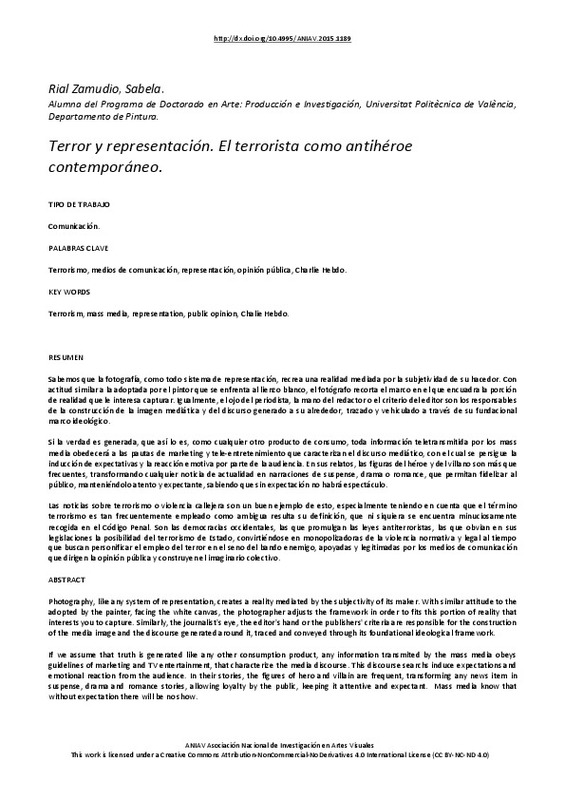JavaScript is disabled for your browser. Some features of this site may not work without it.
Buscar en RiuNet
Listar
Mi cuenta
Estadísticas
Ayuda RiuNet
Admin. UPV
Terror y representación. El terrorista como antihéroe contemporáneo
Mostrar el registro sencillo del ítem
Ficheros en el ítem
| dc.contributor.author | Rial Zamudio, Sabela
|
es_ES |
| dc.date.accessioned | 2017-10-30T10:33:58Z | |
| dc.date.available | 2017-10-30T10:33:58Z | |
| dc.date.issued | 2015-11-26 | |
| dc.identifier.isbn | 9788490483411 | |
| dc.identifier.uri | http://hdl.handle.net/10251/90245 | |
| dc.description.abstract | [EN] Photography, like any system of representation, creates a reality mediated by the subjectivity of its maker. With similar attitude to the adopted by the painter, facing the white canvas, the photographer adjusts the framework in order to fits this portion of reality that interests you to capture. Similarly, the journalist's eye, the editor's hand or the publishers' criteria are responsible for the construction of the media image and the discourse generated around it, traced and conveyed through its foundational ideological framework. If we assume that truth is generated like any other consumption product, any information transmited by the mass media obeys guidelines of marketing and TV entertainment, that characterize the media discourse. This discourse searchs induce expectations and emotional reaction from the audience. In their stories, the figures of hero and villain are frequent, transforming any news item in suspense, drama and romance stories, allowing loyalty by the public, keeping it attentive and expectant. Mass media know that without expectation there will be no show News about terrorism and street violence are a good example of this, especially considering that the term of terrorism is frequently employed and furthermore its definition is ambiguous, even in the Penal Code. The Western democracies are whom, with the enactment of anti-terrorism laws, but obviating the possibility of state terrorism in their legislation, become monopolistic administrators of legal and normative violence meanwhile seeking to embody the use of terror within the enemy camp, supported and legitimized by the media, who leads the public opinion and builds the collective imagination. | es_ES |
| dc.description.abstract | [ES] Sabemos que la fotografía, como todo sistema de representación, recrea una realidad mediada por la subjetividad de su hacedor. Con actitud similar a la adoptada por el pintor que se enfrenta al lienzo blanco, el fotógrafo recorta el marco en el que encuadra la porción de realidad que le interesa capturar. Igualmente, el ojo del periodista, la mano del redactor o el criterio del editor son los responsables de la construcción de la imagen mediática y del discurso generado a su alrededor, trazado y vehiculado a través de su fundacional marco ideológico. Si la verdad es generada, que así lo es, como cualquier otro producto de consumo, toda información teletransmitida por los mass media obedecerá a las pautas de marketing y tele-entretenimiento que caracterizan el discurso mediático, con el cual se persigue la inducción de expectativas y la reacción emotiva por parte de la audiencia. En sus relatos, las figuras del héroe y del villano son más que frecuentes, transformando cualquier noticia de actualidad en narraciones de suspense, drama o romance, que permitan fidelizar al público, manteniéndolo atento y expectante, sabiendo que sin expectación no habrá espectáculo. Las noticias sobre terrorismo o violencia callejera son un buen ejemplo de esto, especialmente teniendo en cuenta que el término terrorismo es tan frecuentemente empleado como ambigua resulta su definición, que ni siquiera se encuentra minuciosamente recogida en el Código Penal. Son las democracias occidentales, las que promulgan las leyes antiterroristas, las que obvian en sus legislaciones la posibilidad del terrorismo de Estado, convirtiéndose en monopolizadoras de la violencia normativa y legal al tiempo que buscan personificar el empleo del terror en el seno del bando enemigo, apoyadas y legitimadas por los medios de comunicación que dirigen la opinión pública y construyen el imaginario colectivo. | es_ES |
| dc.format.extent | 5 | es_ES |
| dc.language | Español | es_ES |
| dc.publisher | Editorial Universitat Politècnica de València | es_ES |
| dc.relation.ispartof | II CONGRESO INTERNACIONAL DE INVESTIGACIÓN EN ARTE VISUALES | es_ES |
| dc.rights | Reconocimiento - No comercial - Sin obra derivada (by-nc-nd) | es_ES |
| dc.subject | Arte | es_ES |
| dc.subject | Producción artística | es_ES |
| dc.subject | Estética | es_ES |
| dc.subject | Teoría del Arte | es_ES |
| dc.subject | Gestión cultural | es_ES |
| dc.subject | Educación artística | es_ES |
| dc.subject | Investigación artística | es_ES |
| dc.title | Terror y representación. El terrorista como antihéroe contemporáneo | es_ES |
| dc.type | Capítulo de libro | es_ES |
| dc.type | Comunicación en congreso | es_ES |
| dc.identifier.doi | 10.4995/ANIAV2015.1189 | |
| dc.rights.accessRights | Abierto | es_ES |
| dc.description.bibliographicCitation | Rial Zamudio, S. (2015). Terror y representación. El terrorista como antihéroe contemporáneo. En II CONGRESO INTERNACIONAL DE INVESTIGACIÓN EN ARTE VISUALES. Editorial Universitat Politècnica de València. 615-619. https://doi.org/10.4995/ANIAV2015.1189 | es_ES |
| dc.description.accrualMethod | OCS | es_ES |
| dc.relation.conferencename | II Congreso Internacional de Investigación en Artes Visuales. |< real | virtual >| ANIAV2015 | es_ES |
| dc.relation.conferencedate | July 09-10,2015 | es_ES |
| dc.relation.conferenceplace | Valencia, Spain | es_ES |
| dc.relation.publisherversion | http://ocs.editorial.upv.es/index.php/ANIAV/ANIAV2015/paper/view/1189 | es_ES |
| dc.description.upvformatpinicio | 615 | es_ES |
| dc.description.upvformatpfin | 619 | es_ES |
| dc.type.version | info:eu-repo/semantics/publishedVersion | es_ES |
| dc.relation.pasarela | OCS\1189 | es_ES |








